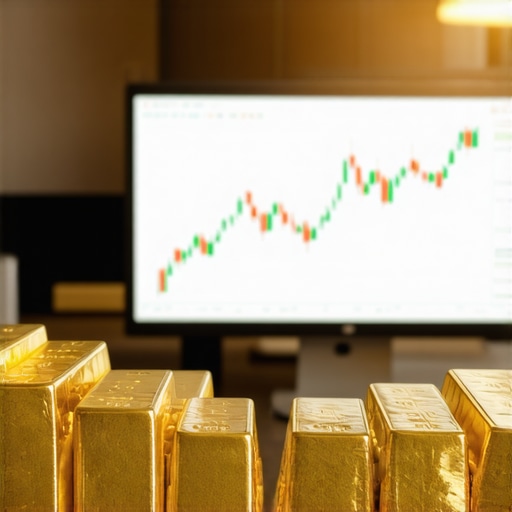Understanding Gold Price Forecasting Techniques for 2025
As we step into 2025, accurately forecasting gold prices becomes increasingly vital for investors and traders alike. The gold market is influenced by a myriad of factors, including economic indicators, geopolitical tensions, and shifts in investor sentiment. With the demand for gold expected to evolve, leveraging effective forecasting techniques can significantly enhance investment strategies.
Key Factors Influencing Gold Prices
To effectively forecast gold prices, it is essential to understand the key factors that drive the market. These include:
- Economic Indicators: Economic stability often leads to fluctuations in gold prices. For instance, inflation rates, interest rates, and employment data can all impact investor behavior. Understanding these indicators allows for better predictions regarding gold price movements.
- Geopolitical Events: Political instability or conflicts can lead to an increase in gold demand as a safe-haven asset. Monitoring global events and their potential impact on investor confidence is crucial for accurate forecasting.
- Central Bank Policies: Central banks play a significant role in the gold market by adjusting their reserves. Their buying and selling activities can heavily influence gold prices. Keeping an eye on central bank announcements and policy changes is essential for any forecasting model.
Utilizing Technical Analysis for Gold Price Forecasting
Technical analysis is a powerful tool for predicting gold prices. By analyzing historical price charts, traders can identify patterns and trends that may signal future price movements. Some popular techniques include:
- Moving Averages: This method smoothens price data over a specific period, helping to identify the overall trend. Traders often use the 50-day and 200-day moving averages to spot potential buy or sell signals.
- Relative Strength Index (RSI): The RSI measures the speed and change of price movements, helping to identify overbought or oversold conditions. An RSI above 70 may indicate that gold is overbought, while an RSI below 30 suggests it may be oversold.
- Fibonacci Retracement Levels: This technique uses horizontal lines to indicate areas of support or resistance at the key Fibonacci levels before the price continues in the original direction. Understanding these levels can provide valuable insights into potential price reversals.
For a deeper understanding of market dynamics, it’s also beneficial to explore analyzing gold market trends and how they can inform investment strategies. Investors must stay informed about the latest market developments and adjust their forecasting techniques accordingly.
Fundamental Analysis in Gold Forecasting
In addition to technical analysis, fundamental analysis plays a critical role in forecasting gold prices. This involves evaluating the intrinsic value of gold based on various economic and financial factors.
- Supply and Demand Dynamics: Understanding the balance between gold supply and demand is vital. Factors such as mining output, recycling rates, and demand from sectors like jewelry and technology can significantly influence prices.
- Market Sentiment: Investor sentiment often dictates market movements. Utilizing sentiment analysis tools can help gauge market psychology and inform forecasting efforts.
As we delve further into 2025, recognizing the evolving landscape of gold demand trends is essential. For insights into these shifts, consider exploring gold demand trends for 2025 and how they may impact your investment decisions.
Exploring Advanced Techniques for Gold Price Forecasting
As we navigate through 2025, investors are increasingly turning to advanced techniques for gold price forecasting to make informed investment decisions. Beyond the basics of technical and fundamental analysis, several sophisticated methods can enhance your predictive capabilities. Understanding these techniques will not only improve your forecasting accuracy but also help you adapt to the ever-changing dynamics of the gold market.
Sentiment Analysis in Gold Price Forecasting
One of the emerging approaches in gold price forecasting is sentiment analysis. This technique involves evaluating the overall mood of the market, which can be gauged through various sources such as news articles, social media, and financial reports. By analyzing sentiment, investors can identify potential market movements influenced by public perception and emotional responses.
For effective sentiment analysis, tools such as natural language processing (NLP) can be utilized to sift through vast amounts of data. By assessing whether the sentiment is positive, negative, or neutral regarding gold, investors can position themselves advantageously. To dive deeper into market dynamics and sentiment, consider exploring current gold market analysis and its implications for investors.
Quantitative Models for Predicting Gold Prices
Another advanced technique involves the use of quantitative models. These models leverage statistical methods and mathematical equations to analyze historical data and forecast future price movements. Commonly used models include time series analysis and econometric models that account for multiple variables affecting gold prices.
- ARIMA Models: The Autoregressive Integrated Moving Average (ARIMA) model is widely used for time series analysis. It helps in understanding and predicting future values based on past data points, making it a valuable tool for gold forecasting.
- Regression Analysis: By establishing relationships between gold prices and various economic indicators, regression analysis can provide insights into how changes in these indicators may influence future prices.
Integrating quantitative models with traditional analysis can significantly enhance forecasting accuracy. For a comprehensive understanding of how these models work, consider reviewing insights on gold mutual funds and their correlation with price movements.
Algorithmic Trading and Gold Price Predictions
Algorithmic trading has revolutionized how traders approach gold investments. By utilizing algorithms that execute trades based on predefined criteria, investors can capitalize on price fluctuations more efficiently. These algorithms often incorporate technical indicators, historical data, and real-time market conditions to make rapid trading decisions.
For those interested in exploring algorithmic trading, understanding the underlying strategies and their effectiveness is crucial. Many traders find success by combining algorithmic strategies with rigorous backtesting to ensure their methods align with market trends. For tips on successful trading techniques, you might want to check out tips for gold trading that can enhance your approach.
The Role of Global Economic Indicators
Finally, never underestimate the impact of global economic indicators on gold prices. Factors such as GDP growth rates, unemployment statistics, and changes in consumer spending can all serve as early signals for potential price movements. Regularly monitoring these indicators equips investors with the knowledge to pivot their strategies effectively.
As you refine your gold price forecasting techniques, it’s essential to remain adaptable and continually update your methods based on market conditions. This adaptability can lead to more effective investment strategies and greater success in navigating the complex world of gold trading. For further insights into gold demand trends, consider exploring gold demand trends for 2025 and their implications for your investment strategies.
Understanding the Impact of Global Events on Gold Prices
In 2025, the gold market is expected to be significantly influenced by global events. Investors should closely monitor international relations, economic sanctions, and trade agreements, as these factors can lead to sudden shifts in gold demand. For example, during periods of heightened geopolitical tensions, gold often sees a surge in demand as a safe-haven asset. Understanding this relationship can provide valuable insights for forecasting.
Geopolitical Risks and Their Influence on Gold Demand
Geopolitical risks can create uncertainty in the markets, leading to increased interest in gold. Events such as elections, military conflicts, or diplomatic negotiations can result in fluctuating prices. A notable example is the impact of the Ukraine conflict on gold prices, which saw significant spikes as investors sought stability. By analyzing historical data related to geopolitical events, investors can develop a more nuanced understanding of how such risks may affect gold prices in 2025. For further insights, explore current gold market analysis.
Connecting Economic Indicators with Gold Price Trends
Economic indicators serve as crucial signals for predicting gold price movements. Indicators such as inflation rates, employment figures, and GDP growth are integral in shaping investor sentiment. For instance, rising inflation can lead to a shift towards gold investment as a hedge against currency devaluation. Monitoring these indicators regularly can empower investors to make informed decisions regarding their gold investments.
Additionally, understanding the correlation between gold prices and other asset classes, such as stocks or bonds, can help investors anticipate market movements. For a deeper dive into gold’s role within investment portfolios, consider reviewing the role of gold in a diverse investment portfolio.
Exploring the Role of Technology in Gold Trading
As technology continues to evolve, its role in gold trading has become increasingly significant. Investors who leverage technological advancements can enhance their trading strategies and improve forecasting accuracy.
Utilizing Trading Platforms for Real-Time Insights
Modern trading platforms provide real-time data and analytics, enabling investors to make timely decisions. These platforms often include advanced charting tools, market news feeds, and alerts that keep investors informed about market fluctuations. Understanding how to effectively utilize these tools can lead to more successful trading outcomes.
Machine Learning and Algorithmic Forecasting
Machine learning algorithms are becoming a prominent feature in gold price forecasting. By analyzing vast amounts of historical data, these algorithms can identify patterns and trends that may not be immediately evident to human analysts. Investors interested in algorithmic trading should consider integrating these technologies into their strategies to enhance precision in their predictions. For those seeking to maximize profits, exploring gold trading techniques can provide valuable insights.
Understanding the Effects of Environmental Factors on Gold Mining
As environmental concerns grow, the gold mining industry faces unique challenges that can impact gold supply and, consequently, prices. Factors such as regulatory changes, sustainability practices, and climate change can affect mining operations.
Regulatory Changes and Gold Supply
Regulatory changes aimed at protecting the environment can limit mining activities, leading to decreased gold supply. Investors should stay informed about these regulations and their potential impact on the market. Additionally, understanding the implications of sustainable mining practices can help investors assess the long-term viability of gold investments.
As we continue to explore the complexities of gold price forecasting in 2025, it is essential to keep adapting strategies in response to emerging global trends and technological advancements. For a comprehensive overview of market dynamics, consider diving into insights into gold demand trends and how they shape investment strategies.
Understanding the Effects of Environmental Factors on Gold Prices
As we delve deeper into the dynamics of gold prices in 2025, it is imperative to consider the impact of environmental factors on both gold mining and the overall market. The gold industry is increasingly affected by sustainability practices, climate change, and regulatory changes, making it vital for investors to remain informed about these influences.
Environmental Sustainability in Gold Mining
With growing awareness of environmental issues, gold mining companies are under pressure to adopt sustainable practices. This shift can lead to changes in gold supply, as stricter regulations may limit mining activities. Investors should keep abreast of these developments, as they can significantly impact market prices. For example, sustainable mining practices often require higher operational costs, which could translate to increased gold prices as supply diminishes.
Climate Change and Its Impact on Gold Supply
Climate change poses challenges to gold mining operations around the world. Extreme weather events can disrupt supply chains and mining activities, leading to fluctuations in gold availability. Additionally, regions that are traditionally rich in gold deposits may become less accessible due to environmental changes. Monitoring climate-related impacts will be crucial for investors seeking to understand long-term price trends in the gold market.
Regulatory Challenges Facing Gold Mining
Regulatory changes aimed at protecting the environment can have profound implications for gold mining. Stricter regulations may lead to reduced mining permits, thus affecting the amount of gold that can be extracted. Investors need to analyze how these regulations influence supply and demand dynamics. For further insights on the relationship between regulations and gold pricing, check out understanding the basics of gold mining stocks.
Technological Innovations in Sustainable Mining
Technological advancements are paving the way for more sustainable mining practices. Innovations such as cleaner extraction methods and improved waste management systems can help reduce the environmental footprint of gold mining. As these technologies become more prevalent, they may mitigate some of the supply constraints caused by regulatory pressures. For insights on how technology impacts investment strategies, consider exploring effective gold investment strategies.
Investor Considerations in a Changing Landscape
In light of these environmental factors, investors should adopt a holistic view of the gold market. This means not only considering traditional economic indicators but also recognizing the implications of environmental sustainability and regulatory landscapes. For a more comprehensive understanding of how these elements interact, investors may benefit from reviewing insights into gold demand trends and their potential impact on investment decisions.
As the gold market continues to evolve, staying informed about environmental factors and their implications can provide a competitive edge. By understanding the interconnectedness of these elements, investors can make more informed decisions and adapt their strategies to navigate the complexities of the gold market effectively.
Frequently Asked Questions About Gold Price Forecasting
What factors influence gold prices in 2025?
Gold prices in 2025 are influenced by several key factors including economic indicators, geopolitical events, central bank policies, and market sentiment. Economic factors such as inflation rates and interest rates play a crucial role, while geopolitical tensions can increase gold demand as a safe-haven asset.
How can technical analysis help in forecasting gold prices?
Technical analysis helps traders identify patterns and trends in historical price charts, which can signal future price movements. Techniques such as moving averages, Relative Strength Index (RSI), and Fibonacci retracement levels are commonly used to make informed trading decisions.
What is fundamental analysis in the context of gold price forecasting?
Fundamental analysis involves evaluating underlying economic factors that affect gold prices, such as supply and demand dynamics, mining production, and investor sentiment. This analysis helps investors gauge the intrinsic value of gold and forecast potential price movements.
How does sentiment analysis affect gold trading?
Sentiment analysis assesses the overall mood of the market by analyzing public perception through news articles, social media, and financial reports. Understanding market sentiment can provide insights into potential price movements and help investors make informed trading decisions.
What role do global economic indicators play in gold price forecasting?
Global economic indicators like GDP growth rates, unemployment statistics, and inflation rates significantly influence gold prices. Monitoring these indicators allows investors to anticipate market trends and adjust their investment strategies accordingly.
How can algorithmic trading improve gold price predictions?
Algorithmic trading uses algorithms to execute trades based on predefined criteria, allowing investors to capitalize on price fluctuations quickly. By incorporating technical indicators and historical data, these algorithms can enhance forecasting accuracy and trading efficiency.
What are the environmental factors affecting gold mining and prices?
Environmental factors such as climate change, sustainability practices, and regulatory changes impact gold mining operations. These factors can affect gold supply, which in turn influences market prices. Investors should remain informed about these environmental influences.
How can technological advancements aid in gold price forecasting?
Technological advancements, including trading platforms and machine learning algorithms, enhance gold price forecasting by providing real-time data and identifying patterns in historical data. These tools help investors make more accurate predictions and improve trading strategies.
Why is it important to stay updated on gold market trends?
Staying informed about gold market trends is essential for investors as it allows them to adapt their strategies to shifting market dynamics. Understanding trends in gold demand, technological advancements, and geopolitical events can lead to more successful investment decisions.
Authority Resources for Gold Prices and Forecasting
To gain deeper insights into gold price forecasting and market dynamics, consider exploring the following trusted resources:
- World Gold Council: A leading authority on gold with valuable research and insights.
- Bloomberg Market Prices: Provides up-to-date gold prices and market analysis.
- Investopedia – Gold: Offers comprehensive articles and tutorials on gold investing and price forecasting.
- Kitco: A trusted source for precious metals information and market news.
- Reuters Commodities: Reliable news source for commodity markets, including gold.
Conclusion
As we move through 2025, understanding gold price forecasting techniques is vital for making informed investment decisions. By combining technical and fundamental analysis with insights from sentiment analysis and technological advancements, investors can navigate the complexities of the gold market. Staying up-to-date with global economic indicators and environmental factors will further enhance forecasting accuracy. With the right tools and resources, investors can effectively adapt their strategies and seize opportunities in the ever-evolving landscape of gold trading.











I found the emphasis on combining multiple forecasting techniques for 2025 particularly insightful. In my experience, relying solely on traditional technical analysis like moving averages or RSI sometimes misses sudden market shifts influenced by geopolitical tensions or central bank moves. The integration of sentiment analysis seems like a powerful addition, especially considering the influence of news and social media nowadays. However, I’m curious about the practical challenges investors face in implementing sentiment analysis—especially how to filter out noise versus meaningful market sentiment. Also, the environmental factors on gold supply present a fascinating but often overlooked aspect. Climate change and regulatory shifts could indeed limit mining operations and push prices upward, but they also add uncertainty to forecasting models. How are other investors accounting for these environmental variables in their strategies? Has anyone found effective ways to balance traditional indicators with these emerging complexities in gold price forecasting? It would be great to hear different approaches or tools other readers are using to stay ahead in this dynamic market.
Megan — great questions. Regarding practical sentiment analysis: I’ve found the biggest wins come from a few simple filters before trusting any signal. First, weight sources (official news > niche blogs > social media) and exclude bot-heavy accounts; second, use topic modeling to ensure sentiment is about gold specifically (not general market panic); third, treat sentiment as a volatility trigger rather than a directional signal—confirm with a price/volume breakout or macro indicator before acting. Tools I’ve used: FinBERT-style models for finance-specific sentiment, RavenPack for curated news sentiment, and simple NLP stacks (spaCy + a pretrained transformer) for quick prototypes. Backtest everything and use ensemble signals (sentiment + RSI + macro surprises) so one noisy input won’t swing decisions.
On environmental variables: incorporate mining production forecasts, regulatory permit pipelines, and even satellite/port activity if you can access it. Scenario analysis (e.g., tighter regs in a major producer) and stress-testing your model against supply shocks helps quantify risk. I’d love to hear which data providers others rely on for mining/sustainability signals and whether anyone has practical heuristics to reduce false positives from social chatter.